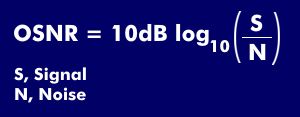optical signal to noise ratio (fiber optics) (OSNR)
The optical signal-to- noise ratio (OSNR) is one of the most important characteristic values for the performance of optical networks( ON). It is defined for optical transmission systems as the ratio of optical signal power to noise power. The latter is significantly affected by the Amplified Spontaneous Emission( ASE) generated by optical amplifiers.
The OSNR is important in that it indicates the degradation of the optical signal in systems with optical amplifiers. So, among others, the bit error rate( BER) of the optical transmission system, which is caused by the attenuation of the optical signal, by dispersion, polarization and unbalanced amplification, and is empirically related to the OSNR.
Generally, the optical signal-to-noise ratio is determined from the logarithm of the optical signal level to the noise, and is expressed in decibels. There are several evaluation methods. For example, the linear interpolation method relates the signal level of the modulated optical signal to the average of the noise in the unmodulated wavelength bands. Here, the unmodulated optical channels are referenced to a normalized bandwidth of, for example, 0.1 nm.
The OSNR can be represented in the eye diagram. If the optical signal has only low noise and a sufficient level so that the zeros and ones are easily recognizable, the eye diagram shows open, on the other hand it is unclear.


-und-OSNR-fuer-eine-Monomodefaser.png)